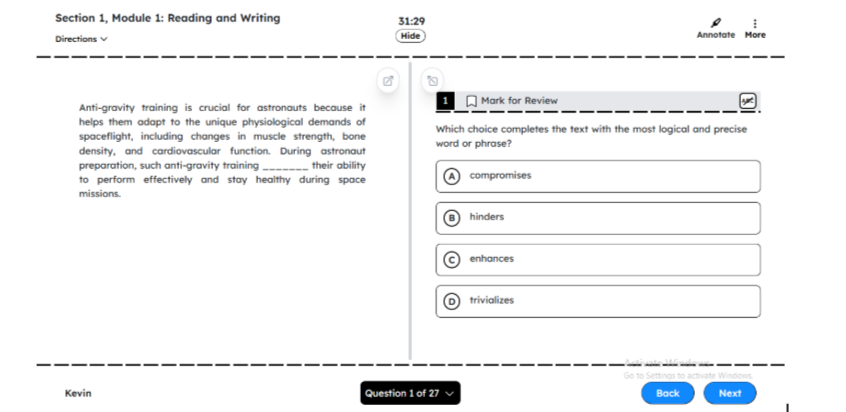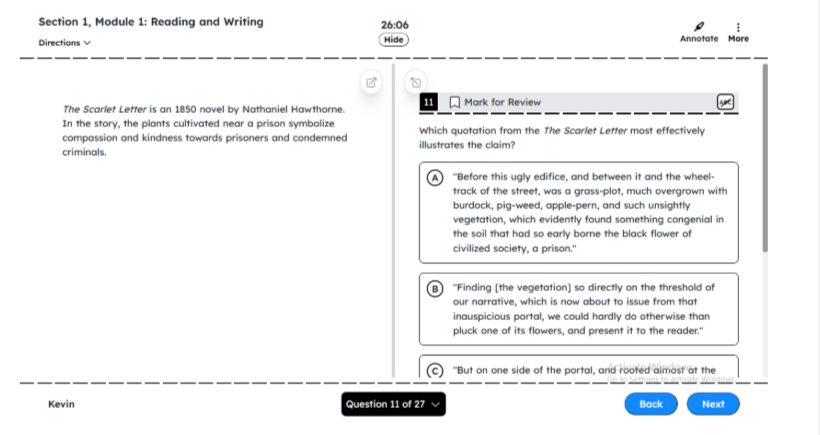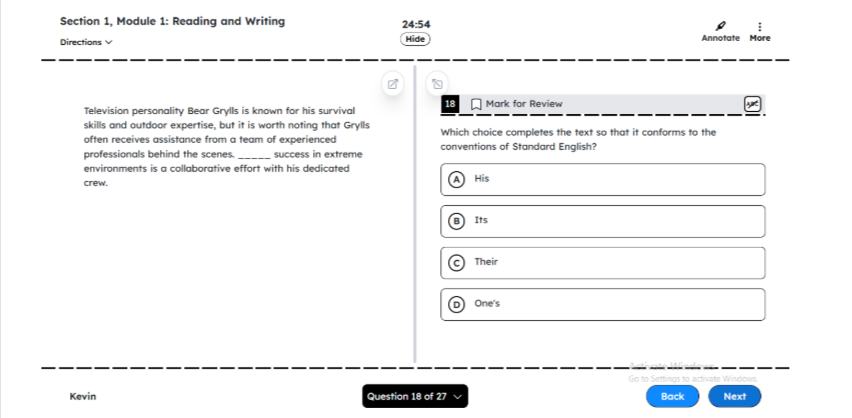




Key Takeaways
- PSAT Reading requires active comprehension, evidence-based answers, and contextual vocabulary skills.
- Time management and early module accuracy are key for higher adaptive scores.
- Digital practice builds stamina, reduces fatigue, and improves on-screen reading focus.
Students try to gather as many PSAT Reading tips as they can, because the Reading and Writing section is worth half the total score of the PSAT. The section is text-heavy, so without the right PSAT reading comprehension techniques, students are quite likely to experience fatigue.
Besides, there is the time-pressure that’s omnipresent in such tests.
All this means that students will need three things to do well in the PSAT Reading section: Strategies that leverage the student’s strengths, practice material that’s relevant, and structured tutoring that’s focused on the result.
In this article, we look at the most important PSAT reading section tips for tutors. Along with that, we’ll examine the challenges tutors face while helping their students for this section and how the right tools can make a huge positive change to that. But first, we’ll quickly summarize everything you need to know as PSAT tutors and how the PSAT reading differs from regular classroom reading.
What tutors should know about the PSAT Reading section
As a tutor, you want to know everything about the PSAT, especially the details of the Reading section. It has two equal modules, each with 27 multiple-choice questions to be answered in 32 minutes. That’s an average of about 1 minute 11 seconds per question. There’s one question per passage, and while students can move freely within a module, they cannot return to it once the module ends.
The below four types of questions are asked:
- Craft and Structure
- Information and Ideas
- Standard English Conventions
- Expression of Ideas
These questions assess skills like evidence-based reading, vocabulary in context, logical reasoning, and core conventions of standard written English.
The Reading section stands out for two reasons. First, it may include tables or charts - no calculations needed, just inferences. Second, the digital format changes the experience: on-screen reading, scrolling, and shorter passages demand sharper focus. Your PSAT Reading tips must address these shifts, as even a single word can be the answer or the entire passage will be required for the answer.
How PSAT Reading differs from standard classroom reading
The PSAT Reading section has some unique types of questions (see the screenshot). But that’s not the only thing that makes the section different from standard classroom reading.
The below aspects that make this section unique explain the need to use special PSAT reading comprehension techniques
- Active comprehension: Students need to identify evidence, tone, and inference, which requires deeper engagement.
- Evidence-based focus: There’s no room for personal opinions; answers must be based purely on the evidence that the passage provides.
- Unfamiliar topics: The section has historical documents, scientific articles, and literary excerpts. Students may not have seen these topics in their regular curriculum.
- Contextual understanding: Words must be understood carefully from the text. This usage may be different from conventional, dictionary meanings.
- Adaptive testing: The digital PSATquestion in the second module adjusts based on the student’s performance in the first module. Hence, the strategies for the two sections need to be slightly different.
Types of questions for PSAT Reading
The PSAT tests Craft and Structure, Information and Ideas, Standard English Conventions, and Expression of Ideas. When students ask how to prepare for PSAT reading, Edison’s free practice PSAT is a great way to train them on relevant question types.
Let’s explore the most common ones.
1. Filling the blank contextual
The most common phrase students will see on the question is ‘Which choice completes the text with the most logical and precise word or phrase?’
Sometimes, two choices are close in meaning, like the choices ‘compromises’ and ‘hinders’ in the adjoining screenshot. At that point, it’s best to ask ‘Should I be looking for a negative word (like ‘hinders’) or a positive word (like ‘enhances’)?’

2. Finding the best support
Some passages take a clear stand on a given topic. For instance, an author might be arguing that leadership is a learned and acquired skill rather than something you’re born with. The question asks the test-taker to select an option that best supports the author’s point of view.
The adjoining image is a great example for such questions.

3. Conventions of Standard written English
English conventions evolve over time. So what was correct decades ago may now be outdated (thought not incorrect). Since this is an American exam, ensure students understand American English rules.
Some questions follow routine grammar rules, while others need a nuanced approach where strong tutoring and quality prep material matter most.

4. Correlating two pieces of text
It’d be safe to say that these questions are unique to the section of PSAT reading. Tutoring strategies need to be really specific for answering these questions.
The sample question shows two texts: Text 1 challenges a traditional theory, while Text 2 mentions experts suggesting additional observation methods. The question asks how they relate to each other.

17 PSAT Reading tips tutors should teach for maximum results
To help tutors support students with high-impact PSAT Reading prep, here are over 17 practical strategies to integrate into sessions.
1. Encourage active reading, with notes
Teach students to engage with the text by questioning the author’s choices, tone, and purpose. Encourage them to note key phrases and consider why the author chose specific wording and how contextual usages matter.
Example: In his short story Sometimes They Come Back, the famous writer Stephen King writes… “Period six was a grammar course, dry as chalkdust.” This is significant, because the protagonist was a teacher, so chalkdust was a relevant and interesting usage. A chef would have described a dull, uninteresting movie as “...bland as unseasoned tofu.”
2. Teach avoiding personal biases
Your PSAT reading tutoring strategies must help answer questions based only on the passage, not their own beliefs or outside knowledge. This keeps responses aligned with test logic. As an example, the minimum driving age, without supervision, in the US is 16 or 17 (depending on the state). However, other countries may have a higher limit, typically for specialized vehicles.
Example: If a passage says a controversial law reduced crime, the answer must reflect that claim, even if the student disagrees in real life.
3. Help identify direct and implied stand
Just when your students start reading practice material and figuring out their own ways on how to prepare for PSAT reading, explain to them what’s clearly stated and what’s implied.
Show students how to spot the author’s explicit stance (direct) and the subtle hints that reveal underlying opinions (implied).
Example: “I oppose the policy” is a clear and direct stand. Contrast it with this “The policy, though well-intentioned, failed to address the core issue” hints at disapproval without stating it outright. This is an implied stand.
4. Aim for a strong performance in the 1st module
In the adaptive PSAT, the second module’s difficulty as well as the student’s
scoring potential depends on the first module’s performance. Doing well early unlocks a more challenging second module. Understanding how PSAT scoring works is vital.
But that is actually good, and here’s why: Once the student gets a difficult 2nd module, their minimum overall score will always be higher than the maximum overall score if the 2nd module had been easier.
Teach students to focus on aiming for more accuracy and speed in the first module.
Example: A student who answers 80% correctly in Module 1 might face harder passages in Module 2, but those questions carry more scoring weight, raising their potential score range.
5. Explain how numbers are critical
Numbers in passages often carry precise meaning and can change the answer entirely. Students must pay attention to data, comparisons, and qualifiers.
Example: “Sales rose by 35%” is different from “Sales nearly doubled.” Against that, some words, even without a number, can suggest a certain threshold. For instance, when you read ‘most students opted for biology’, you can safely interpret that more than half, i.e. more than 50% of the students opted for biology.
6. Practice paraphrasing
In a sense, this tip is about active reading. Have students practice PSAT reading comprehension techniques by restating sentences in their own words. This will immediately expose if there are gaps in their understanding. Alongside that, paraphrasing helps avoid misreading complex phrasing.
Example: Original: “The treaty curtailed, but did not eliminate, emissions.” Paraphrase: “The treaty reduced emissions, but some still occurred.”
7. Spot error patterns and weak areas
Encourage tracking of recurring mistakes so tutoring sessions can target those skills directly. This both personalizes your teaching (thereby adding value) and ensures score improvement.
Example: If a student repeatedly misses “vocabulary-in-context” questions, dedicate extra practice to that type. Suggest some extra practice material.
8. Work with diverse topics
Expose students to a range of genres - science, literature, history, art movement - so unfamiliar topics don’t cause panic on test day. However, this is one of the slightly misunderstood PSAT reading tutoring strategies. The goal is not to provide additional knowledge to the student; the goal is to familiarize them with different subjects and writing styles.
Example: Practice reading both an 1800s political speech and a modern scientific article. A piece of literature from the early 20th-century will, for instance, be quite different from the fiction pieces that The New Yorker currently publishes.
9. Stop students from generalizing
It’s a fact that under the test pressure, students often make sweeping assumptions beyond the text. They are quite likely to misinterpret a few examples as universal expressions.
Example: If the passage says “Many students enjoy online learning,” don’t assume all students do. This can also get culture-specific or gender-biased based on images nurtured in popular media. ‘A brave soldier’ often brings to mind the picture of a male.
10. Carry out grammar drills
While this is one of the most common PSAT Reading tips, we cannot emphasize it enough.
Reinforce grammar skills that support clarity in comprehension and eliminate wrong answers in detail-focused questions.
Example: Understanding subject-verb agreement can help identify why “The results of the experiments was surprising” is incorrect. See our earlier blog on specific ACT grammar rules for a complete discussion.
11. Teach time management for each passage
Students should learn to allocate time evenly so that they don’t rush at the end. Use practice tests to help them stick to time limits.
How: There are 27 questions to be completed in 32 minutes; that’s about 71 seconds per question. But keep reminding students that they can save time on easier questions, and thus allocate more time to lengthy or challenging questions.
12. Practice eliminating wrong answer choices systematically
This is one of our favorite PSAT reading section tips for tutors. Encourage students to identify and cross out options that are too extreme, off-topic, or unsupported. This narrows the guess range when unsure. Sometimes, a systematic elimination is all that’s required to arrive at the correct answer.
Example: If a choice says “all scientists agree” but the passage shows only “most scientists,” eliminate it as too absolute.
13. Show why pointer words matter
Certain words like however, although, hence, or despite clearly point the direction in which the next set of arguments the author will take in a passage. That’s why we call them pointer words. Some pointer words (like hence) will continue the line of reasoning, while others (like however) completely reverse the direction.
Example: The army was about to win the battle easily. However, their commander … When you reach this stage, you know you can expect a contradictory statement. Perhaps the commander committed a blunder, perhaps the commander had overlooked certain risks… whatever. But it’s sure that the moment the word “however” appears, it will steer things into a different direction.
14. Make sure students use online tools
Train students to use all available digital features (like highlighting, underlining, annotation, and answer review) to stay organized and improve accuracy.
Example: Highlighting “however” or “despite” in a passage helps spot shifts in tone or argument quickly during review.
15. Explain general limitations of theories
Most theories hold true only within specific timelines or groups, but exceptions are possible. Since they’re developed while keeping certain factors constant and are tested in controlled environments, real-world results often vary.
Example: A passage mentions a car advertising a mileage of 38 miles a gallon. However, you should remember that this mileage was recorded under test conditions. Real driving would be different, so the mileage wouldn’t necessarily be 38 miles a gallon.
16. Train for vocabulary-in-context questions
Teach students to use surrounding sentences to find meaning. Make sure they do not rely on any prior knowledge. Over time, your students would learn to pick up the nuances of how the same word can be used to evoke different reactions.
Example: If the sentence reads, “Her remark was caustic, stinging the pride of her opponent,” context shows “caustic” means “harsh” or “biting,” not “acidic.”
17. Emphasize finding textual evidence before answering
One of the key PSAT Reading tips is to have students locate the exact phrase, sentence, or paragraph supporting their answer. This is especially true for evidence-based questions.
Even when confident, have your students ask: “Is this truly evidence or just my bias?” This is often crucial for older passages; for instance, an early 19th-century text might claim atoms are indivisible, and students must accept it within that context.
Example: If asked “Which choice best supports the claim that…?”, they should scroll to the relevant lines, not rely on memory.
Main challenges tutors face in PSAT Reading prep
Despite all the PSAT Reading tips they’ve learned, even well-prepared students can stumble in the Reading section. That’s not rare. Mental stamina, question interpretation, pacing, confidence, and digital navigation all collide under timed conditions.
You often see the same obstacles holding students back, and each one shaping how you plan and adjust lessons to get the most out of your PSAT reading section tips. For tutors, after all, student outcomes matter the most.
- Students fatigued by long or abstract passages
When assigning dense or abstract passages, you often notice focus starts to wane halfway through. That fatigue means your students will likely miss subtle shifts in tone or skip important details.
- Misinterpreting evidence-based questions
Seen students confidently choose an answer, only to back it up with text that doesn’t quite fit? That’s more common than most students believe. One small mismatch between answer and evidence, and both responses are wrong.
- Rushing through without comprehension
Some students think speed equals efficiency. But when they skim too aggressively, their answers come from incomplete understanding. Helping them balance speed and accuracy is one of the biggest challenges.
- Overconfidence or underconfidence in familiar genres
If the genre feels familiar, say, a modern opinion piece, students often drop their guard because they think ‘they already know it’. On the flip side, an unfamiliar style like 19th-century prose can make them reluctant to give it a proper try.
- Navigating the digital interface while maintaining comprehension
As a tutor, you’ve probably watched students lose their reading rhythm while scrolling back and forth between text and questions. Even tiny disruptions in flow can cost them accuracy in PSAT.
- Struggling to adapt to the test’s adaptive format
Some students don’t realize how important the first module is for unlocking a higher-scoring second module. So make it clear: early accuracy can change their scoring potential, hence they need to stay focused from the very first question and leverage the importance of the first module.
How tutors can use EdisonOS to optimize PSAT Reading prep
Addressing the above challenges becomes easier when tutors combine targeted strategies with the right digital tools. EdisonOS ticks all the boxes for that.
- Assign passage-based drills and monitor progress
EdisonOS allows tutors to assign targeted PSAT reading passages that match PSAT styles and difficulty levels. Consistent tracking of performance over time reveals whether accuracy is improving or stagnating. This will also tell you if they’re fully putting into practice your PSAT reading strategies. Use Edison’s BYOT (Build Your Own Test) feature to achieve this.
- Use data to track comprehension metrics
Drill down to key metrics such as time spent per question, accuracy by question type, and performance trends to provide a clear picture of student progress. This insight helps shape more effective lesson plans.
- Offer personalized reading paths and quizzes
Along with PSAT reading tutoring strategies, use reading Edison’s practice sets to address specific weaknesses. Perhaps it’s vocabulary-in-context that stumps a student? Or maybe they make mistakes in paired passages? Or evidence-based reasoning is their weak link? Edison helps you ensure each student’s practice time is focused and relevant.
- Simulate the reading section experience digitally
Running drills in a digital format helps students adjust to the scrolling, interface, and pacing of the real test. It also builds familiarity with answering questions directly on screen. And - needless to add - you can make sure your students fully utilize the various on-screen tools.
- Share reading analytics with students for review
When students see their own reading patterns (e.g. where they slow down or overlook key details) they are more motivated to improve. Concrete data turns vague feedback into actionable next steps.
Conclusion: Help your students master the PSAT Reading with strategic instructions
Helping your students master the PSAT Reading section isn’t just about practicing passages; it’s about equipping students with the right PSAT Reading tips and strategies.
Train with quality material, offer regular tests, and give feedback to help students excel under timed conditions. By tackling challenges, using a reliable platform, and tailoring instruction, tutors can boost confidence and accuracy.
EdisonOS tools track progress, personalize practice, and simulate real tests, turning prep into measurable gains. With strategic guidance and the right resources, tutors can help every student approach the PSAT Reading section with focus, skill, and readiness for their best score.
Why not get in touch with our team and learn more on how out platform can dramatically improve your student’s performance?

Recommended Reads
Recommended Podcasts






.png)




.png)
.webp)
